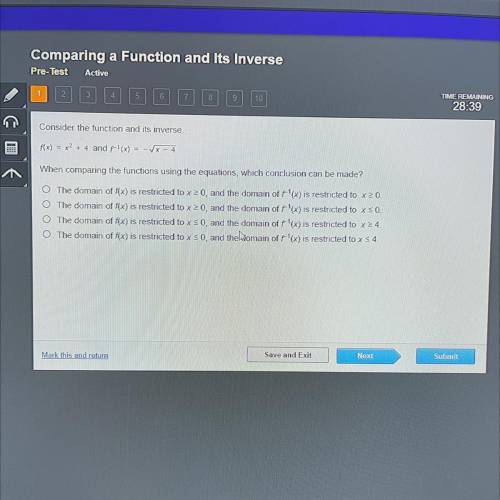Consider the function and its inverse.
f(x) = x2 + 4 and f-1(x) = -x - 4
When comparing the f...

Mathematics, 08.06.2021 09:00 choiboiqg5755
Consider the function and its inverse.
f(x) = x2 + 4 and f-1(x) = -x - 4
When comparing the functions using the equations, which conclusion can be made?
O The domain of f(x) is restricted to x20, and the domain of f'(x) is restricted to x20.
O The domain of f(x) is restricted to x20, and the domain of f'(x) is restricted to xso.
O The domain of f(x) is restricted to x = 0, and the domain of f'(x) is restricted to x2 4.
The domain of f(x) is restricted to x = 0, and theliomain of f'(x) is restricted to x3 4.


Answers: 1


Another question on Mathematics

Mathematics, 21.06.2019 14:40
The height of a triangle is 4 in. greater than twice its base. the area of the triangle is no more than 168 in.^2. which inequalitycan be used to find the possible lengths, x, of the base of the triangle?
Answers: 1

Mathematics, 21.06.2019 16:00
Martin likes to make flower bouquets that have 3 daffodils and 4 tulips per vase. a daffodil has a mass of d grams, a tulip has a mass of t grams, and the vase has a mass of u grams. the expression 5(3d + 4t + v) describes the mass of 5 bouquets. match each amount in the situation with the expression that represents it. situation expression number of bouquets mass of one bouquet mass of the tulips in one bouquet 4t mass of the daffodils in one bouquet 3d + 4t + v
Answers: 2

Mathematics, 21.06.2019 17:50
(01.02 lc) angle abc has point e on ray ba and point d on ray bc. points e and d are equidistant from point b. to bisect angle abc, which of the following needs to be identified for the construction? the distance between points e and d the point in the angle that is equidistant from points e and d the endpoint of rays ba and bc the point outside of the angle that is equidistant from points e and d
Answers: 1

Mathematics, 21.06.2019 21:50
What is the next step in the given proof? choose the most logical approach. a. statement: m 1 + m 2 + 2(m 3) = 180° reason: angle addition b. statement: m 1 + m 3 = m 2 + m 3 reason: transitive property of equality c. statement: m 1 = m 2 reason: subtraction property of equality d. statement: m 1 + m 2 = m 2 + m 3 reason: substitution property of equality e. statement: 2(m 1) = m 2 + m 3 reason: substitution property of equality
Answers: 3
You know the right answer?
Questions

Mathematics, 18.10.2021 20:30

Mathematics, 18.10.2021 20:30


Computers and Technology, 18.10.2021 20:30


English, 18.10.2021 20:30


Mathematics, 18.10.2021 20:30


Physics, 18.10.2021 20:30

Mathematics, 18.10.2021 20:30

Mathematics, 18.10.2021 20:30

History, 18.10.2021 20:30

SAT, 18.10.2021 20:30

Physics, 18.10.2021 20:30





Mathematics, 18.10.2021 20:30



